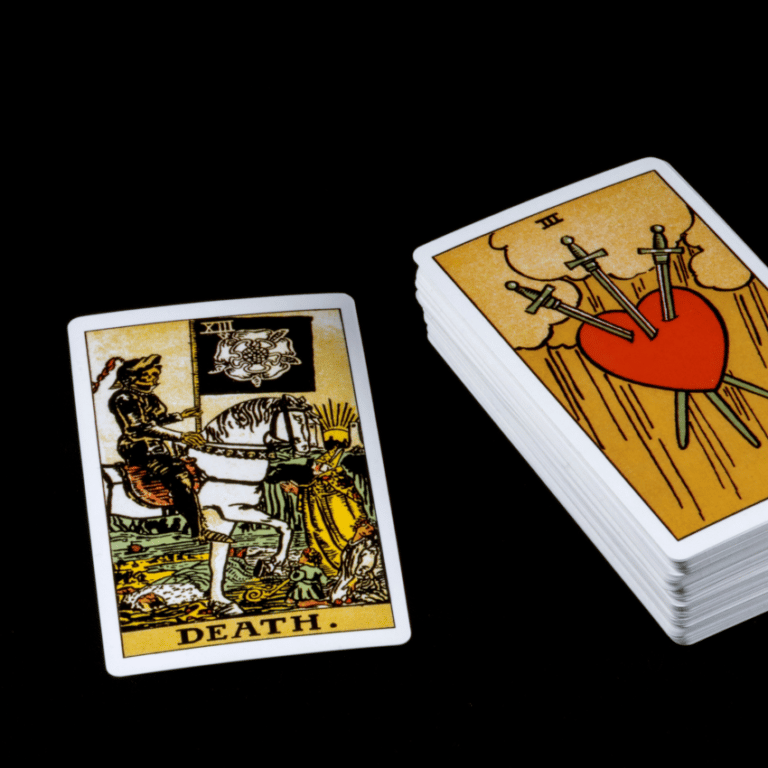The Death Tarot card gets a bad rep. The sight of it in a Tarot reading has struck fear into the hearts of many a sitter who mistakenly think it means death itself.
A good Tarot reader knows that the Death card very rarely means physical death. Plus, even where physical death may be possible depending on surrounding cards, it is something that many readers would not feel comfortable predicting.
In most cases, the Death card means a transition—the death of an old situation to make way for a new one.
So, it’s time to unpack everything about this Tarot card and what its interpretations can mean for you.
What does the Death Tarot Card Mean?
The thirteenth card of the Major Arcana, Death, comes right after the Hanged Man and just before the Temperance card.
The Death card can have several meanings depending on the context, but in all cases, it represents sweeping change, often out of the seeker’s control.
Depending on the reading, it can mean:
- An ending of some kind
- Closing one door and opening another
- Cutting out what isn’t necessary
- Riding the winds of fate
- Accepting what is inevitable
- Being cast adrift
- Shedding old attitudes
- Parting of the ways
What Does the Death Card Mean in Love & Relationships?
In a love and relationship Tarot reading, the Death card points toward a dramatic change. The relationship is going to shift, for good or ill.
If this card is pulled in the position of how someone feels about you, it indicates that the way someone feels has undergone a huge change, and there is no going back.
This could spell the death of someone’s romantic feelings for you. Or it could mean that their previous feelings for you have evolved. For example, if someone felt you were a friend before, they may now have romantic feelings for you.
In regard to how someone sees you, it could mean that they see you in a completely different light. They see that you have changed in some way; therefore, the relationship or friendship has changed.
For what someone wants to happen in your relationship, it means they desire change. Things cannot continue as they are.
Read this next: What is the Tarot Trying to Tell You in a Love Reading?
What Does the Death Card Mean in a Career Reading?
In a career reading, the Death Tarot card signals the end of a way of thinking or of a career or a job.
This may be accompanied by shocking change (if the Tower card appears in the reading too, it could mean being fired from your job).
However, the Death card is not just about endings but beginnings too. While the initial stage of the Death card may cause your world to turn upside down, essentially, it is paving the way for something new and better to come into your life.
Death is a bit like Jupiter return—it brings you what you need, but first, the old things that no longer serve you and have no place in your future must be swept away.
What About Death as an Obstacle?
As an obstacle card, Death indicates that something is standing in your way of progressing forward. It could be a way of thinking and refusing to let go of old thinking patterns. It could be a person. Perhaps a career. Maybe memories from the past will not release you.
It can represent an overdue change that you are not mentally prepared for.
Death as an obstacle still represents change, but the difference is that you may be expressing resistance to change rather than going with the flow.
What About Death in Reverse?
As a reversed card, Death still represents change, but the difference is that you may be expressing resistance to change rather than going with the flow.
This resistance is of your doing. But the energy of the Death card is not in your power to control. You may be struggling between letting go of control and fighting to keep hold of it. There may be desperation to cling to what is familiar and comfortable to you. It is almost as if you are fighting with the universe itself.
A battle between Ego and Soul is prominent with the Death reversed card.
This position also represents the sign of Scorpio, which must wrestle between its Ego and Soul before the Soul claims victory.
Lessons of the Death Card
The Death card brings great lessons with it because it is the card that represents change and transformation.
People with strong Scorpio energy in their birth charts will understand this card very well because transformation is a common and recurring theme in their lives. Often, this transformation is painful.
Neither literal nor figurative death is easy to deal with. It brings great pain and suffering in many instances. But out of this pain comes enlightenment and strength. It is a tale as old as time.
Regeneration is the outcome of the Death card. The old way dissolves to make way for the new. It is one of our souls’ most profound and intense lessons.
We cannot always control what happens to us in life. When Death is at work, it brings finality. But it also brings evolution and possibility too. It is through Death that we come to learn so much about life.
Related article: You Pulled the World Card – Now What?
